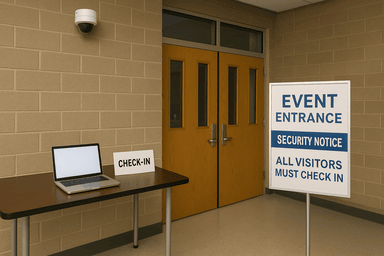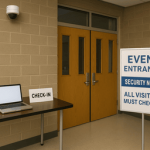
Whether it’s a Friday night football game, a spring musical, or parent-teacher conferences, school events create a unique challenge for campus security—open doors, increased traffic, and lots of unfamiliar faces. These events are essential for community engagement, but without the right planning, they can introduce unnecessary risk.
At SSP, we help educational institutions strike the right balance between being welcoming and staying secure. Here’s what every school should consider when preparing for a safe, successful event.
k
k
Why School Events Need Special Security Attention
Unlike a normal school day, after-hours events break routine security protocols. Here’s how:
-
Multiple open entry points for crowd convenience
-
Visitors unfamiliar with security procedures or campus layout
-
Reduced staff presence compared to school hours
-
Increased anonymity, making it harder to identify guests or respond quickly in an emergency
Security planning shouldn’t stop at the school bell. In fact, after-hours incidents are more common because of the loosened structure and visibility.
k
k
🔐 Smart School Event Security Tips
1. Consolidate Entry and Exit Points
Instead of propping open every door, funnel attendees through designated access points.
-
Use 1–2 monitored entrances
-
Assign staff or volunteers to greet and observe incoming guests
-
Lock or alarm all other doors
-
For larger events, consider mobile access readers or badge check-in stations
Real-World Tip: One Georgia high school SSP worked with uses color-coded wristbands to indicate attendee types—students, parents, guests, and staff—making identification easier at a glance.
k
k
2. Use Temporary Visitor Management Solutions
You don’t need full registration like a school day, but some record-keeping is critical.
-
QR codes or digital forms for RSVP/check-in
-
Printed badges for volunteers, vendors, and media
-
Digital guest logs to reference in case of emergencies
Bonus: Some visitor management systems integrate with your access control platform—perfect for larger campuses or multi-building events.
k
k
3. Layer Security Staff and Surveillance
Crowd control isn’t just about numbers—it’s about strategic placement.
-
Station staff at high-traffic or blind spots (hallways, stairwells, exits)
-
Assign a roaming team to respond to issues
-
Install temporary surveillance in gymnasiums, auditoriums, and fields
Pro Tip: SSP offers solar-powered mobile surveillance towers that can be deployed temporarily for high-visibility deterrence and live monitoring.
k
k
4. Plan for Emergency Communication
If something goes wrong, how will you communicate?
-
Test the PA system ahead of time
-
Provide walkie-talkies to key event staff
-
Draft an emergency response plan and share it during a pre-event briefing
Include contingency plans for:
-
Medical emergencies
-
Severe weather
-
Suspicious activity
-
Lockdown or evacuation
k
k
5. Don’t Overlook Parking and Perimeter Security
A secure campus starts at the edge:
-
Illuminate parking lots and paths
-
Use cones or barricades to separate foot and vehicle traffic
-
Assign staff or school resource officers to parking lots
Example: A metro-area charter school we support uses a rotating team of student safety cadets and staff to guide cars, improving flow and visibility without needing outside security contractors.
k
k
6. Set Clear Expectations with Guests
Use flyers, emails, or signage to communicate:
-
Where to enter
-
What areas are off-limits
-
Behavioral expectations
-
Re-entry and exit policies
When everyone knows the plan, incidents are far less likely—and easier to manage when they do arise.
k
k
The SSP Difference: Security That Supports Your Community
School events should never feel like a risk. At SSP, we specialize in school-specific solutions that include:
-
Mobile and temporary surveillance units
-
Cloud-based visitor management platforms
-
Integrated access control for large or shared-use campuses
-
On-demand security planning consultations
Whether you’re hosting a district-wide open house or a single-campus talent show, we can help you build a smart plan that protects students and staff—without making your event feel like a lockdown.


